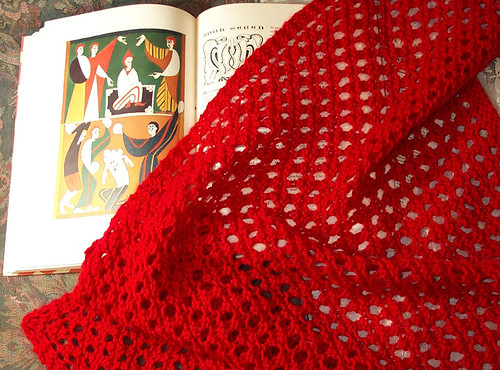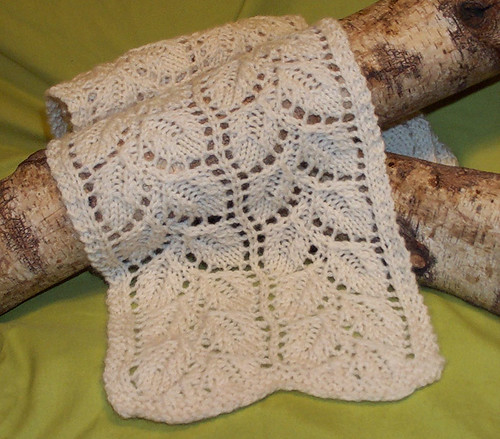Today was
my day. I arrived home from work with a hunch that I would see a parcel from
KnitPicks with my name on it and sure enough, there is was. I carefully opened the package and beheld what I had longed to behold (for seven business days at least)... my spanking new
Knitpicks Options Harmony Wood Interchangeable Knitting Needle Set! My quest for interchangeable knitting needles came about last November. I decided that an interchangeable set would be the most practical and economical way of obtaining a good arsenal of assorted knitting needles. I did a bit of research on interchangeable sets and the Harmony set won me over.
The needles have the perfect feel in my opinion, the birch needle tips have that paradoxical combination of hard and soft texture that makes me partial to wooden needles. The finish on the needles is hard and slick with just that minute amount of "drag" which I'm sure will be much appreciated when working with slippery yarns. The needles are also nicely tapered and have good points. The colors are lovely as well, they're not at all as garish as I was lead by some reviewers to believe. I even think they're more subdued than the pictures on the
KnitPicks website. Then again, I'm of Swedish and
Pennsylvania Dutch heritage so I'm not afraid of color. The joins are smooth and align virtually seamlessly to the cables. The cables have a nice amount of flexibility to them but they're not droopy and have a good bit of memory to them. Overall, I couldn't be more pleased with the construction and appearance of these needles.
Before receiving my set, the one thing I thought I
wasn’t going to like was the case for these needles. It seemed too
plasticky for such pretty wooden needles and it struck me as the type of thing women receive as a freebie from department store cosmetics counters. I was a bit hasty in judgement as I do find it practical for the time being and it snugly holds the needle tips in individual sleeves along each side of the bag. The provided case also leaves room for the size 13US (9.00mm), 15US (10.00mm), and 17US (12.00mm), needle tips (sold
separately), as well as two additional sleeves for what you will. There is room in the center for the bag of cables, cable caps and various other knitting accoutrement. I may however, replace this bag as my only fear is it’s lack of harder, more protective sides. It was suggested to me that I look at sportsmen’s shops for a “worm binder” which is a case that fishermen use for their (synthetic) tackle. The
Browning Fishing Jumbo Worm Binder looks like it would do the trick nicely.
I had also read a complaint that they
didn’t come with any type of instructions as to how to properly attach the needles to the cables. I beg to differ; the card that is enclosed with the cables (the thing said complainer probably pulled out and threw away), has the instructions printed right on it, and frankly it's not that hard to figure out. I liked
KnitPicks low-profile, low-waste product packaging, I wish more companies were as conscientious. Mind you, everything was packaged securely enough to arrive unscathed.
Because
KnitPicks has the lovely policy of free shipping for orders over $50US I picked up two little extras with the money I had set aside in case of shipping & handling fees. I bought a set of the
Needle Size ID Tags which are sturdy and convenient, as the needles themselves are not marked. I was also pleased that these tags displayed both Metric and US sizes. Finally I picked up a
KnitPicks View Sizer, while not as pretty as the metal sheep needle sizer I had my eye on, it is solid and quite practical. It's a needle-sizer, magnifier, ruler, gauge check, and pattern marker all in one. This is also far more handy than my current (now previous), model.
In closing, I'll wrap up this review with...
The Rundown: Knitpicks Options Harmony Wood Interchangeable Needle SetWhat You Get:- Nine pairs of laminated birch needle tips. Sizes 4US (3.5mm), 5US (3.75mm), 6US (4.00mm), 7US (4.50mm), 8US (5.00mm), 9US (5.50mm), 10US (6.00mm), 10.5US (6.50mm), and 11US (8.00mm).
- Two 24" cables and two 32" cables.
- Eight end caps (for storing work on cables or making "straight" needles.
- Two cable keys for ensuring a snug fit when joining needle tips to cables.
- A vinyl cable case.
- A large zippered vinyl storage case with compartments for needle tips and room for additional pieces and notions.
Cost: $69.99US
***EDIT*** I previously forgot to mention I was also pleased with the needle tip length on these. The needle tips (from join to point) are approximately 4 1/2 inches (11 1/2cm) long with the wooden part (just the wooden "working area" excluding metal join) being approximately 3 1/3 inches (8 1/2 cm) long (this varies from size to size but the total length seems consistant). This suits me nicely as some interchangeables had much shorter needles and I have big hands.













